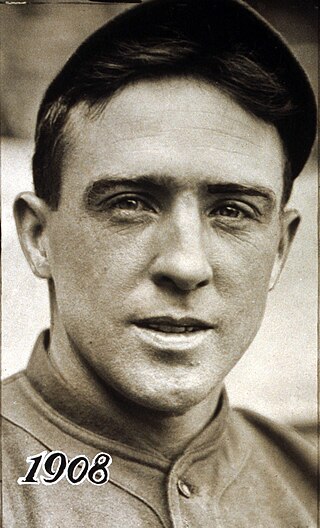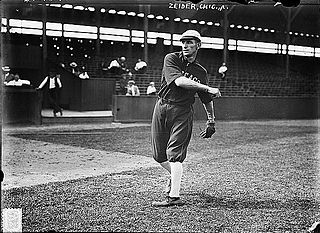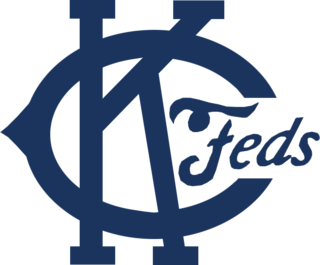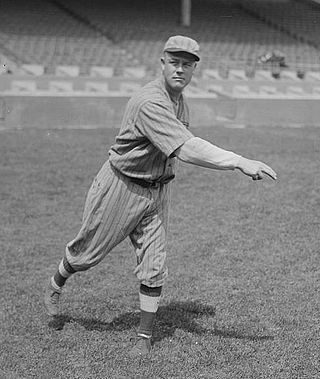
Wrigley Field is a Major League Baseball (MLB) stadium on the North Side of Chicago, Illinois. It is the home of the Chicago Cubs, one of the city's two MLB franchises. It first opened in 1914 as Weeghman Park for Charles Weeghman's Chicago Whales of the Federal League, which folded after the 1915 baseball season. The Cubs played their first home game at the park on April 20, 1916, defeating the Cincinnati Reds 7–6 in 11 innings. Chewing gum magnate William Wrigley Jr. of the Wrigley Company acquired the Cubs in 1921. It was named Cubs Park from 1920 to 1926, before being renamed Wrigley Field in 1927. The current seating capacity is 41,649. It is actually the second stadium to be named Wrigley Field, as a Los Angeles ballpark with the same name opened in 1925.

The Federal League of Base Ball Clubs, known simply as the Federal League, was an American professional baseball league that played its first season as a minor league in 1913 and operated as a "third major league", in competition with the established National and American Leagues, from 1914 to 1915.

The Cubs–White Sox rivalry refers to the Major League Baseball (MLB) geographical rivalry between the Chicago Cubs and Chicago White Sox. The Cubs are a member club of MLB's National League (NL) Central division, and play their home games at Wrigley Field, located on Chicago's North Side. The White Sox are a member club of MLB's American League (AL) Central division, and play their home games at Guaranteed Rate Field, located on Chicago's South Side.

Joseph Bert Tinker was an American professional baseball player and manager. He played from 1902 through 1916 for the Chicago Cubs and Cincinnati Reds of Major League Baseball (MLB) and the Chicago Whales of the Federal League.

West Side Park was the name used for two different ballparks that formerly stood in Chicago, Illinois. They were both home fields of the team now known as the Chicago Cubs of the National League. Both ballparks hosted baseball championships. The latter of the two parks, where the franchise played for nearly a quarter century, was the home of the first two world champion Cubs teams, the team that posted the best winning percentage in Major League Baseball history and won the most games in National League history (1906), the only cross-town World Series in Chicago (1906), and the immortalized Tinker to Evers to Chance double-play combo. Both ballparks were primarily constructed of wood.

Rollie Hubert Zeider was a professional baseball player. An infielder, he played nine seasons in the major leagues for the Chicago White Sox (1910–13), New York Yankees (1913), Chicago Chi-Feds/Chicago Whales in the Federal League from 1914–15, and lastly the Chicago Cubs (1916–18).
The Pittsburgh Rebels were a baseball club based in Pittsburgh, Pennsylvania, from 1913 to 1915. The team was a member of the short-lived Federal League. The team was originally called the Pittsburgh Stogies after an earlier Pittsburgh team that played in the Union Association in 1884, but became known as the Rebels by the end of the 1914 season. The team played all of its home games at Exposition Park, located on Pittsburgh's Northside. The Pittsburgh Pirates of the National League left the stadium for Forbes Field in 1909. After the Rebels left Exposition Park in 1915, the field was demolished and its property became part of the adjacent rail yards.
The following are the baseball events of the year 1967 throughout the world.
The following are the baseball events of the year 1961 throughout the world.
The following are the baseball events of the year 1959 throughout the world.

The Kansas City Packers were a Federal League baseball club in Kansas City from 1914 to 1915. They finished sixth in 1914 with a 67–84 record, and fourth in 1915 with an 81–72 record.
The following are the baseball events of the year 1942 throughout the world.

Charles Henry Weeghman was a German American restaurant entrepreneur and sports executive. Beginning in 1901, he began opening quick-service lunch counters throughout downtown Chicago. After failing to acquire the St. Louis Cardinals baseball club in 1911, he became one of the founders of the upstart Federal League in 1913 as the owner of the Chicago Whales. In 1914, he built the baseball stadium that would later be known as Wrigley Field.

The St. Louis Terriers were a baseball club that played in the short-lived Federal League in 1914 and 1915. They played their home games at Handlan's Park. The team was owned by ice magnate Phil Ball, who later was owner of the St. Louis Browns.

Claude Raymond Hendrix was a professional baseball pitcher who played in the National League for the Pittsburgh Pirates (1911–13) and Chicago Cubs (1916–20) and in the Federal League with the Chicago Whales (1914–15). He pitched a no-hitter in 1915 and was the first pitcher to record a victory at Wrigley Field, then named Weeghman Park. In 1921, he was accused of tipping off a gambler to a possibly fixed game in 1920; an allegation that, while not proven, likely ended his career in baseball.
The history of Wrigley Field, the home of the Chicago Cubs of Major League Baseball's National League, begins well before the Cubs played their first game in that venue.

James Alexander Gilmore was an American businessman who served as president of baseball's Federal League when it attempted to become a third major league, alongside the American League and National League, in 1914 and 1915.

Charles Herbert Thomas was the president of the Chicago Cubs of the National League from 1914 through 1916.
The Cleveland Green Sox were a baseball club based in Cleveland, Ohio. In 1913, the Green Sox were charter members of the Federal League. The Cleveland Green Sox were managed by Baseball Hall of Fame member Cy Young and played just the 1913 season before the franchise was folded. Finishing in second place, the Green Sox hosted home games at Luna Park. The Green Sox franchise was ultimately forced out in Cleveland when the major league Cleveland Naps relocated the Toledo Mud Hens to Cleveland for the 1914 season.












